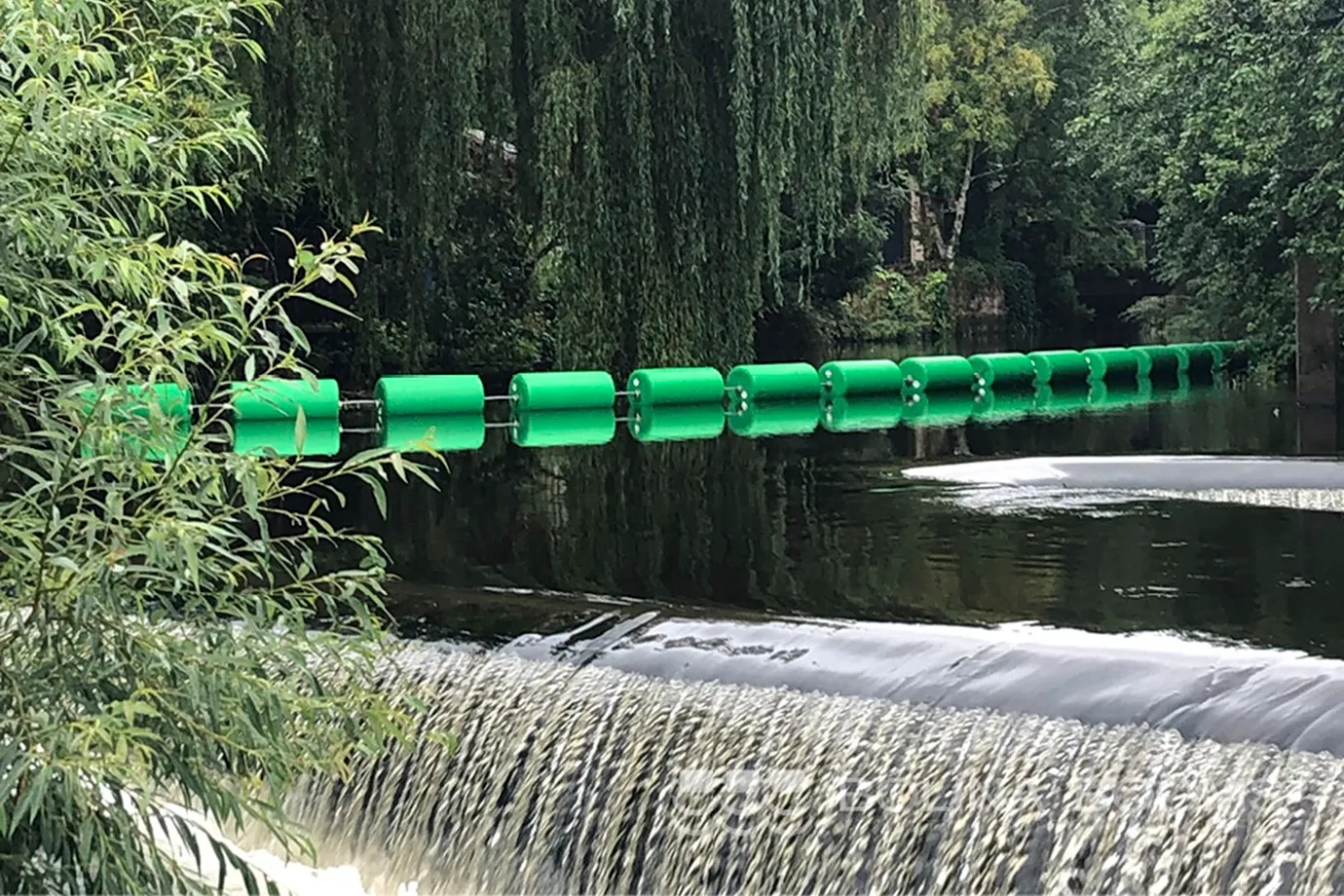Waterways are central to modern infrastructure. From ports and marinas to hydro facilities and nature reserves, they support commercial, recreational, and environmental activity. With increased usage comes the need for reliable safety measures. As risks from climate variability, vessel traffic, and urban expansion continue to rise, implementing durable, visible, and effective safety systems is essential.
This article outlines how Watercraft Safety Booms, Marine Buoys (Navigation, Demarcation, Floating, Light, Mooring), and Hyperion Marine Lanterns contribute to waterway safety.
Whether you’re securing public areas, hydropower plants, or marine facilities, our “safety booms” offer reliable barrier protection and clear visual guidance.

What is a safety boom?

Safety floating booms, as a type of floating booms, are produced to create a barrier in waterways (deployed upstream of hazards such as weirs and sluices) to marine safety by not only stopping drifting and disabled vessels but also by keeping public access away from the dangerous situation. They are ideal for low-head overflow-type dams.
Why Waterway Safety Requires an Integrated System
No single piece of equipment is sufficient to ensure complete safety in dynamic water environments. A well-designed waterway safety strategy integrates physical barriers, visual markers, and lighting systems. These components must withstand harsh environmental conditions, enable clear guidance for users, and allow for adaptable deployment.
Watercraft Safety Booms limit unauthorized or hazardous vessel movement. Marine Buoys mark key navigation paths, swimming areas, and restricted zones. Hyperion Marine Lanterns enhance visibility during low-light or nighttime conditions. Together, they form a complete safety system.
Support is often provided for engineering, planning, installation, and maintenance, with systems tailored to the specific location and conditions.
Watercraft Safety Booms

Watercraft Safety Booms are essential floating barriers designed to control vessel movement and secure specific water zones. They are used to prevent unauthorized or accidental access to areas such as dam spillways, intake points, or protected zones. These booms vary in size, construction, and capability, allowing for tailored solutions depending on the water environment and safety objective.
See also: “Introducing Dam Safety Barrier“
They also help mitigate risks such as:
- Human injury near hazardous water flows
- Damage to infrastructure from uncontrolled vessels
- Environmental impact from accidental entries into protected ecosystems
These systems can be permanent or seasonal and are adaptable based on site-specific environmental conditions and regulatory requirements.
Canoe Boom (CAB)
Canoe Booms are designed to block access to small watercraft such as canoes, kayaks, and dinghies. They are constructed from closed-cell polyethylene floats and connected by wire ropes made of galvanized or stainless steel. These systems are modular and come in multiple sizes (CAB400 to CAB1000), allowing customization based on application needs.
CABs are suitable for:
- Nature reserves
- Water treatment sites
- Recreational lakes
They are easy to install and maintain and offer long service life with low operational requirements.
Traffic Control Boom (TCB)
Traffic Control Booms are intended for larger and more active water zones. Featuring robust floatation units linked by galvanized steel tubes, these booms are designed to manage high-impact forces and heavy-duty use. They are ideal for:
- Dam sites
- Hydropower stations
- Port entry points
TCBs are available in sizes from 400mm to 1000mm, ensuring the correct specification for a variety of environmental demands.
Marine Buoys | Aids to Navigation
Marine buoys serve as critical tools for navigation, zoning, and mooring in marine and inland waters. Each buoy type has a specific function that contributes to safety and operational clarity in aquatic environments. Below is a breakdown of the various buoy types and their intended applications.
They also support:
- Maritime traffic regulation
- Designated access for emergency response
- Ecological protection through zoning
NNavigation Buoy
Navigation Buoys assist vessels in following designated routes and avoiding underwater hazards. ENB-1200 and ENB-1500 models are suitable for strong wave and current conditions. These buoys feature:
- UV-stabilized polyethylene
- Internal concrete ballast
- Compliance with IALA guidelines
They are commonly deployed near harbor entries, along river shipping lanes, and within dredging zones.
Demarcation Buoy
These buoys help define water zones such as swimming boundaries, private mooring areas, or danger zones. The ENB-400 to ENB-750 series provides high visibility and ease of deployment for short to moderate exposure environments.
They are ideal for:
- Seasonal water activity zones
- Restricted access to ecological or industrial areas
- Public safety in multi-use waterways
Floating Buoy
Floating Buoys are used in calmer, sheltered waters and are ideal for temporary installations. EFB-400 and EFB-650 models are frequently used in:
- Special events
- Construction zones
- Temporary navigation routes
They can be rapidly deployed, repositioned, or stored between uses.
Light Buoy
Light Buoys like the ELB-650 include integrated LED lighting powered by solar energy. Bluetooth controls allow users to adjust light settings remotely. Applications include:
- Swimming zones
- Resort demarcation
- Low-light navigation support
Their self-contained power systems make them suitable for remote or off-grid areas.
Mooring Buoy
The EMB-650 offers durable mooring capability for small to medium-sized vessels. With UV-resistant foam and internal filling, it is designed for frequent or long-term deployment in marinas and harbors.
It supports safe mooring for:
- Research craft in protected waters
- Fishing vessels
- Recreational boats
Hyperion Marine Lanterns

Marine lanterns enhance visibility on the water, especially in low-light or nighttime conditions. The Hyperion series includes a range of self-contained, solar-powered LED beacons that integrate with buoys or other fixed markers. These lanterns vary in brightness, range, and programmability to suit different marine environments.
They are used to:
- Enhance visibility in emergency deployments
- Illuminate hazard zones
- Support navigation during night or fog
HL-1 Lantern
This entry-level lantern provides visibility from 1 to 3 nautical miles. It includes 32 programmable flash patterns and offers over 16 days of autonomous function. Designed for inshore applications, it is compact, lightweight, and easy to integrate with buoys or standalone mounts.
HL-3 Lantern
The HL-3 model extends visibility up to 5 nautical miles. Its durable housing and expanded battery capacity support long-term use in busier waterways. It includes 256 programmable flash patterns and waterproof construction.
HL-5 Lantern
Designed for high-traffic or offshore conditions, the HL-5 reaches up to 6 nautical miles of visibility. With a larger solar module and 12Ah lithium-ion battery, it ensures performance in remote or demanding installations.
Installation and Maintenance Considerations
Deploying marine safety equipment requires planning and periodic upkeep to maintain performance over time. Important considerations include:
- Site-specific assessments (depth, tide, wave energy)
- Environmental impact studies
- Seasonal weather variations
- Inspections for UV, salt, and mechanical wear
Preventive maintenance extends the service life of booms, buoys, and lanterns. Float replacement, mooring checks, and lighting recalibration should be scheduled according to environmental conditions and operational load.
See also: “Safety Boom Installation“
Applications of safety booms

Safety Booms have different applications and are used in different waterways (waterways, marinas, private water bodies, nature reserves, etc.). Below are the general applications of safety booms:
1- Create a safety barrier to prevent even the smallest of craft from passing.
2- Ideal for flood defenses and navigation authorities to protect lives, vessels, and structures.
3- Ideal for beach markers, small channel identifiers, and other uses where a floating line of demarcation is required.
4- Use as a demarcation of recreational areas to deter marine traffic and stop jellyfish from entering at the same time.
System Support and Customization
Project support may include planning, design calculations, and training. Environmental loads can be analyzed using simulation software to ensure structural reliability. Documentation and system certifications are also available.
Products can be tailored to meet regulatory requirements or operational specifications. Options include customized colors, signage, and anchoring solutions.
Conclusion
Waterways present unique safety challenges. With integrated systems that combine physical booms, navigational aids, and lighting, risks can be managed effectively. A wide range of marine safety equipment is available to support both public and private sector initiatives in building safer water environments.
A safety boom creates a bright, physical barrier that warns and restrains small craft from entering hazardous zones (e.g., dam spillways, intakes, fast channels). Public-safety guidance for dams explicitly calls for boat-restraining barriers as part of risk controls.
– CAB (Canoe Boom): compact, modular float elements with 16 mm wire rope (min. break load 12 T) and typical float spacing 1,250–1,800 mm—ideal for canoe/kayak exclusion in moderate energy.
– TCB (Traffic Control Boom): adds HDG steel tube cores for higher loads; min. break loads up to 72 T on larger sizes.
– Demarcation Buoys (ENB-400/600/700/750) — IALA-compliant, with published freeboard/visibility ranges to mark restricted or cautionary areas around the boom.
– Navigation Buoys (ENB-1200/1500) — for high-energy, deeper water; focal plane 1,650–1,750 mm, visibility area ~1.25–2.25 m².
Pair the system with Hyperion self-contained solar lanterns:
– HL-1: visible 1–3 NM, 32 user-selectable patterns.
– HL-3: 3–5 NM, 256 patterns.
– HL-5: 4–6 NM, 256 patterns.




